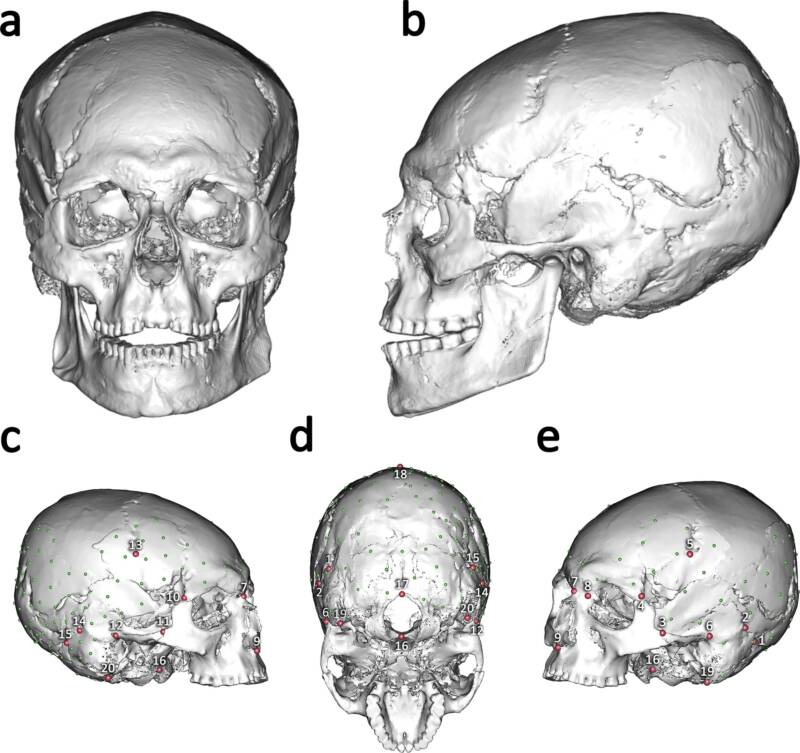This elongated skull was unearthed alongside dozens of Stone Age skeletons arranged in a ritualistic tableau inside Italy's Arene Candide Cave.

T. Mori et al./Scientific ReportsA digital reconstruction of the elongated skull originally found in the 1940s in northern Italy’s Arene Candide Cave.
A 12,500-year-old skull discovered in Italy in the 1940s may be the earliest example of artificial cranial modification (ACM) in European history, according to a new study.
ACM is a form of body modification in which pressure is applied to an infant’s head as it grows, usually by binding the skull with fabric or a board, in order to create an elongated shape. Recent research on a skull discovered inside a cave along the northwestern coast of Italy has shed new light on how far back ACM was practiced in Europe.
The Skull Unearthed In Arene Candide Cave Is Found To Be The Oldest Cranial Modification In European History

T. Mori et al./Scientific ReportsPhotos of the elongated skull, which is currently housed in the Museum of Anthropology in Florence.
The skull, known as AC12, was found inside Italy’s Arene Candide Cave in a part of the site known as the “Tomb of the Antlers.” The site was used as a cemetery thousands of years ago, with some remains dating as far back as 11,600 to 12,500 years ago.
Though the skull was found in pieces, it was reconstructed in the 1970s, further revealing its elongated shape.
Since its initial reconstruction, scientists have struggled to settle on an explanation as to how the skull came to be shaped in such an unusual way. Possible theories included trauma or injury to the head during childhood, or the impacts of some sort of disease.
Now, a new study published in Scientific Reports suggests that the head shape was changed on purpose, making AC12 the earliest recorded instance of ACM in Europe.
Researchers used CT scans to virtually deconstruct the skull. They then used the separated bones to reconstruct AC12 in four different ways.
Using geometric morphometrics, which is a way to analyze bone shape, the researchers compared the four versions of the reconstructed skull with other skulls. This revealed that AC12 was more similar to other purposefully modified skulls than it was to either normal skulls or skulls impacted by trauma and disease.
Researchers believe this particular modification was carried out by wrapping the head with fabric around its circumference during infancy.
The Mystery Of Why The AC12 Skull Was Modified

T. Mori et al./Scientific ReportsThe elongated skull, as it was when it was first uncovered in the 1940s.
While scientists do not know exactly why this type of modification was practiced, it’s likely that the reasons, and the cultural significance behind them, varied across peoples and regions.
“Cultural body modification was likely an ancient and widespread practice,” study co-author Irene Dori explained to Live Science. “It may have been one of the several practices used to express identity and transmit social norms.”
The AC12 skull was not the only example of body modification uncovered at the Arene Candide Cave archaeological site. Some remains of teeth have revealed that some people may have decorated their faces with cheek plugs.
However, it’s difficult to tell how common modifications like ACM or cheek plugs were in the region because many of the skulls and other remains are fragmented.
Arene Candide Cave is not the only region where evidence of ACM or other modifications have been unearthed. There is evidence of ACM in Asia dating back 11,600 years, as well as evidence of the practice in Australia from more than 13,000 years ago. ACM was also widely practiced throughout Central and South America.
“It is possible that this practice arose independently in different regions,” Dori said. “The available evidence does not allow us to determine definitively whether cranial modification was independently invented or culturally transmitted between groups.”
Indeed, for now, this prehistoric practice remains largely shrouded in mystery.
After reading about this elongated Stone Age skull, discover the story behind dozens of elongated skulls< found in Hungary that had connections to the fall of Rome. Then, learn about how Viking women may have purposefully elongated their skulls 1,000 years ago.





